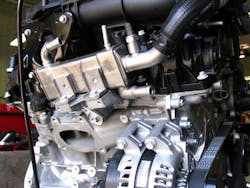In the light truck arena, engine needs basically boil down to two things: power and fuel economy. For commercial users, that means more horsepower and torque in a lighter weight package that sips less fuel during the course of a rough-and-tumble workday.
Fiat Chrysler Automobile (FCA) is taking a renewed stab at this complex – and often contradictory – set of goals with a redesign of its gasoline-fired 3.6-liter Pentastar V-6 engine for the 2016 model year.According to Bob Lee (at right), FCA North America's VP for engine, powertrain, electrified propulsion and systems engineering (can you fit all that on a business card?) this redesigned V-6 delivers fuel-economy improvements of more than 6% while increasing torque more than 14.9%; a torque boost that occurs at engine speeds below 3,000 rpm, where such elevated torque has its most profound impact on the driving experience.
“We focused our efforts on improving efficiency and providing greater customer satisfaction in a package that delivers superior value,” he explained in a statement, with increased fuel-efficiency the “key impetus” in redesigning 3.6-liter Pentastar.
Lee said FCA powertrain engineers evaluated multiple technologies, accumulating more than 4.7 million customer-equivalent miles using computer simulation and physical tests, with no improvement in fuel economy proving “too small to chase.”
He believes that “most compelling enhancement” to FCA’s 3.6-liter Pentastar is two-step variable valve lift or “VVL,” which is designed to remain mostly in low-lift mode until the customer demands more power. Then it responds by switching to high-lift mode for improved combustion.
Lee said the result is less overall pumping work, which on its own, accounts for a fuel-economy improvement of up to 2.7% compared with the 3.6-liter Pentastar’s previous iteration.
The addition of cooled exhaust gas recirculation (EGR) to the 3.6-liter not only reduces emissions but also helps further cut so-called “pumping losses” and enables knock-free operation at higher, real-world loads.
This translates to a fuel-economy improvement, on its own, of up to 0.8%, Lee noted.
Pumping losses are also targeted with the 3.6-liter’s upgraded variable valve timing (VVT) system, which moves to torque-driven cam-phasing in 2016 to reduce oil demand.The new VVT system also increases its range of authority to 70 degrees, from 50 degrees, Lee noted, helping further mitigate “knock” during hot starts and expands the operating envelope of engine stop start (ESS), a fuel-saving feature that is carried over from the previous-generation 3.6-liter Pentastar.
More torque can also be delivered more quickly by recalibrating the VVT system to leverage the benefits of the new intake manifold’s longer runners – resulting in that aforementioned torque boost of over 14.9%, depending on the vehicle application, between 1,000 and 3,000 rpm.
All this within an engine that weighs as little as 326 lbs., depending on the application, which is four pounds less than the previous 3.6-liter Pentastar despite the addition of new components weighing 13 pounds.
Lee highlighted several specific weight-reduction efforts:
- A thin-wall strategy was used to reduce the nominal thickness of certain die-cast components – without compromising noise, vibration and harshness (NVH) characteristics.
- Slashing windage-tray weight by 19% and front-cover weight by 5%.
- Two-piece oil pans were also eliminated, except for Trail Rated vehicles.
- The engine’s crankshaft also went on a diet. Its main bearings and pins were trimmed, which contributed to an overall block-assembly weight reduction of six pounds.
A final note: for model-year 2016, FCA said all of its U.S. engines – except for the 8.4-liter V-10 that powers the Dodge SRT Viper – will be E15-compatible, in anticipation of the proliferation of that 85% gasoline/15% ethanol fuel blend within the American motor vehicle market.
Something to keep an eye upon if you operate gasoline-powered trucks.





